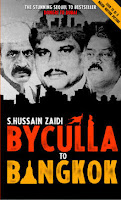Book Review : Byculla to Bangkok by S. Hussain Zaidi (Rating *****)
Most great cities have criminal underbellies. London, New York, Tokyo,
Hong Kong, Moscow, Istanbul—all these have nurtured notorious criminal
networks. Mumbai’s underworld took shape in the 1950s and 1960s. The
pioneering dons came from poor Muslim families—reflecting their
socio-economic marginalisation. After the bomb blasts in 1993, the
ascendancy of the Shiv Sena-led government and the rise of an elite,
trigger-happy police unit, the balance of power shifted in favour of
younger Maharashtrian Hindu mobsters.
In Byculla to Bangkok, S. Hussain Zaidi focuses on this part of the underworld. The nerve-centre of organised crime runs down Mumbai’s own centre. The earlier generation of dons came from the southern end, close to the docks, while their successors lived further mid-town. This lower-middle-class milieu of mill workers, petty government servants and street vendors was host to the dreaded BRA gang (of Babu Reshim, Rama Naik and Arun Gawli) and Amar (Raavan) Naik and his engineer brother Ashwin.
Starting out as small-time trouble-makers, these mobsters found themselves in high demand as the city began to reinvent itself from textile manufacturing centre to financial powerhouse. Real estate, particularly the lucrative stretch of defunct mill land, was the sought after prize. The involvement of politicians in the turf wars was no secret. Bal Thackeray called the Maharashtrian gangsters ‘amchi muley’ (our boys) and Chhota Rajan, grievously wounded in an attempt on his life in Bangkok, was whisked to safety by the Thai military police, suggesting protection at high levels.
In Byculla to Bangkok, S. Hussain Zaidi focuses on this part of the underworld. The nerve-centre of organised crime runs down Mumbai’s own centre. The earlier generation of dons came from the southern end, close to the docks, while their successors lived further mid-town. This lower-middle-class milieu of mill workers, petty government servants and street vendors was host to the dreaded BRA gang (of Babu Reshim, Rama Naik and Arun Gawli) and Amar (Raavan) Naik and his engineer brother Ashwin.
Starting out as small-time trouble-makers, these mobsters found themselves in high demand as the city began to reinvent itself from textile manufacturing centre to financial powerhouse. Real estate, particularly the lucrative stretch of defunct mill land, was the sought after prize. The involvement of politicians in the turf wars was no secret. Bal Thackeray called the Maharashtrian gangsters ‘amchi muley’ (our boys) and Chhota Rajan, grievously wounded in an attempt on his life in Bangkok, was whisked to safety by the Thai military police, suggesting protection at high levels.
The story has the customary amount of bloodspill and treachery, but also
runs in other directions. The phenomenon of encounters and
glorification of policemen specialising in extra-judicial killings of
alleged criminals has been written about before and even made into
movies but Zaidi’s account also sheds light on the envy and ripple
effect it caused in the force. Then there is the effect of
globalisation, the ties to Afghan drug cartels and guerilla networks
such as the LTTE. Also, top gangsters seeking refuge outside the
country: Muslims heading west to Dubai and Karachi, Hindus to Bangkok,
where all they need is “a one-bedroom flat, a TV airing Indian channels
and a telephone to call India to issue threats”.
Zaidi’s book is littered with similar anecdotes and insights. We learn for instance that Gawli’s terrace house is as large as a badminton court; that jails are the equivalent of cafes offering networking opportunities for criminals; that a criminal modus operandi depicted in Scorsese’s Gangs of New York inspired Amar Naik to expand his operations.
As a reporter, Zaidi is limited by a lack of distance and narrative flair that could have injected a sense of the timeless into his material. Parts of the book read like a recitation of well-known facts from newspapers. The absence of financial estimates for what is, after all, a kind of business, is glaring. Anecdotes and stories are often thrown together pell mell, including a tantalising one about a Pathan woman whose beauty was both a source of power and a curse. Notwithstanding the flaws, Zaidi is to be complimented for venturing into risky territory and emerging with a breezy, informative read.
Zaidi’s book is littered with similar anecdotes and insights. We learn for instance that Gawli’s terrace house is as large as a badminton court; that jails are the equivalent of cafes offering networking opportunities for criminals; that a criminal modus operandi depicted in Scorsese’s Gangs of New York inspired Amar Naik to expand his operations.
As a reporter, Zaidi is limited by a lack of distance and narrative flair that could have injected a sense of the timeless into his material. Parts of the book read like a recitation of well-known facts from newspapers. The absence of financial estimates for what is, after all, a kind of business, is glaring. Anecdotes and stories are often thrown together pell mell, including a tantalising one about a Pathan woman whose beauty was both a source of power and a curse. Notwithstanding the flaws, Zaidi is to be complimented for venturing into risky territory and emerging with a breezy, informative read.




Comments
Post a Comment